Management Accounting Report: Principles, Techniques, and Analysis
VerifiedAdded on 2020/12/01
|28
|8475
|118
Report
AI Summary
This report provides a comprehensive overview of management accounting, detailing its principles, processes, and techniques. It explores the management accounting system, its integration within organizations, and its historical origins. The report delves into key concepts such as cost accounting, inventory management, and microeconomic techniques, including cost analysis and cost-volume-profit analysis. It further examines budgeting processes, pricing strategies, and performance measurement tools, including key performance indicators (KPIs). The report also touches upon management's role in areas such as leadership, communication, and knowledge management. It concludes by summarizing the importance of management accounting in decision-making and organizational success. The report is a valuable resource for understanding the multifaceted nature of management accounting and its practical applications.
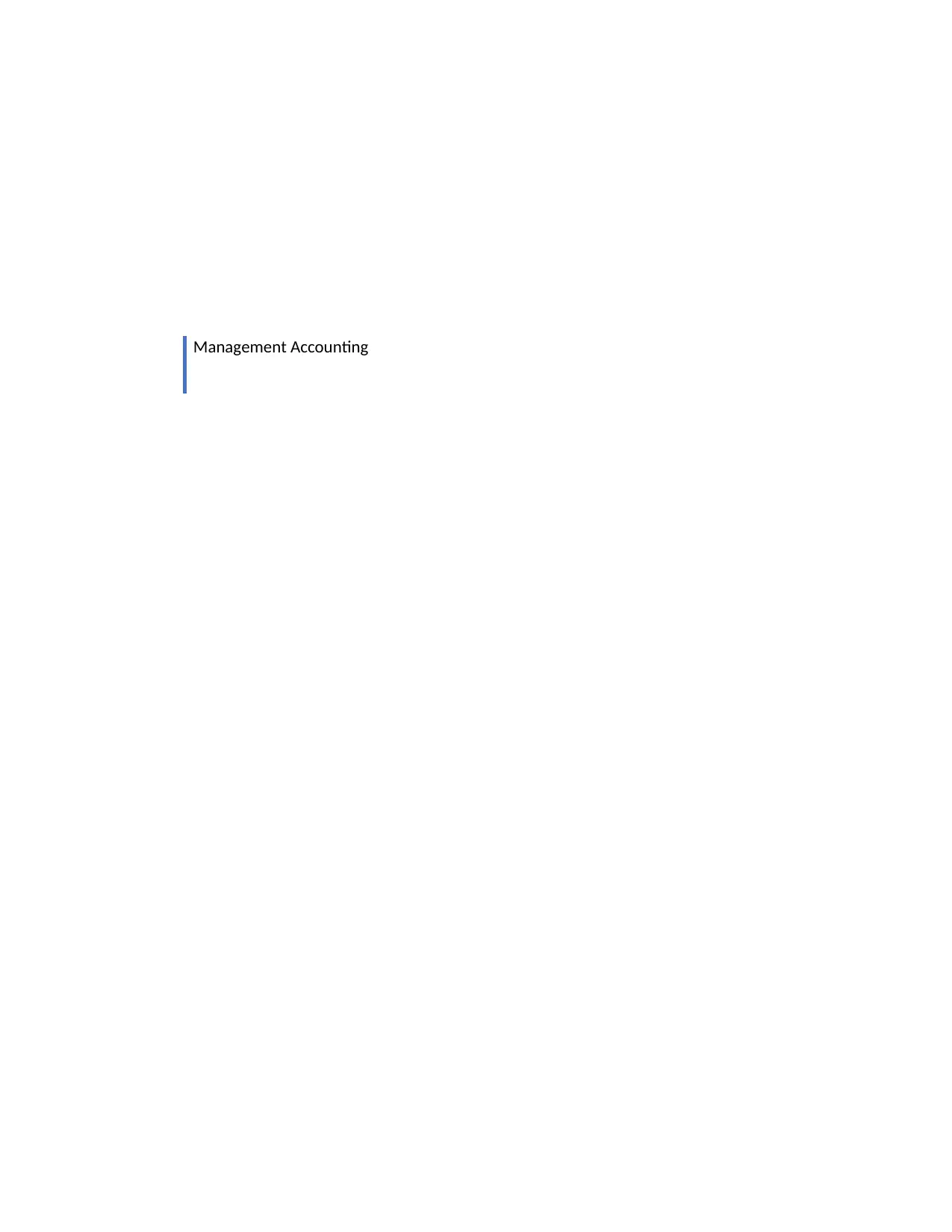
Management Accounting
Paraphrase This Document
Need a fresh take? Get an instant paraphrase of this document with our AI Paraphraser
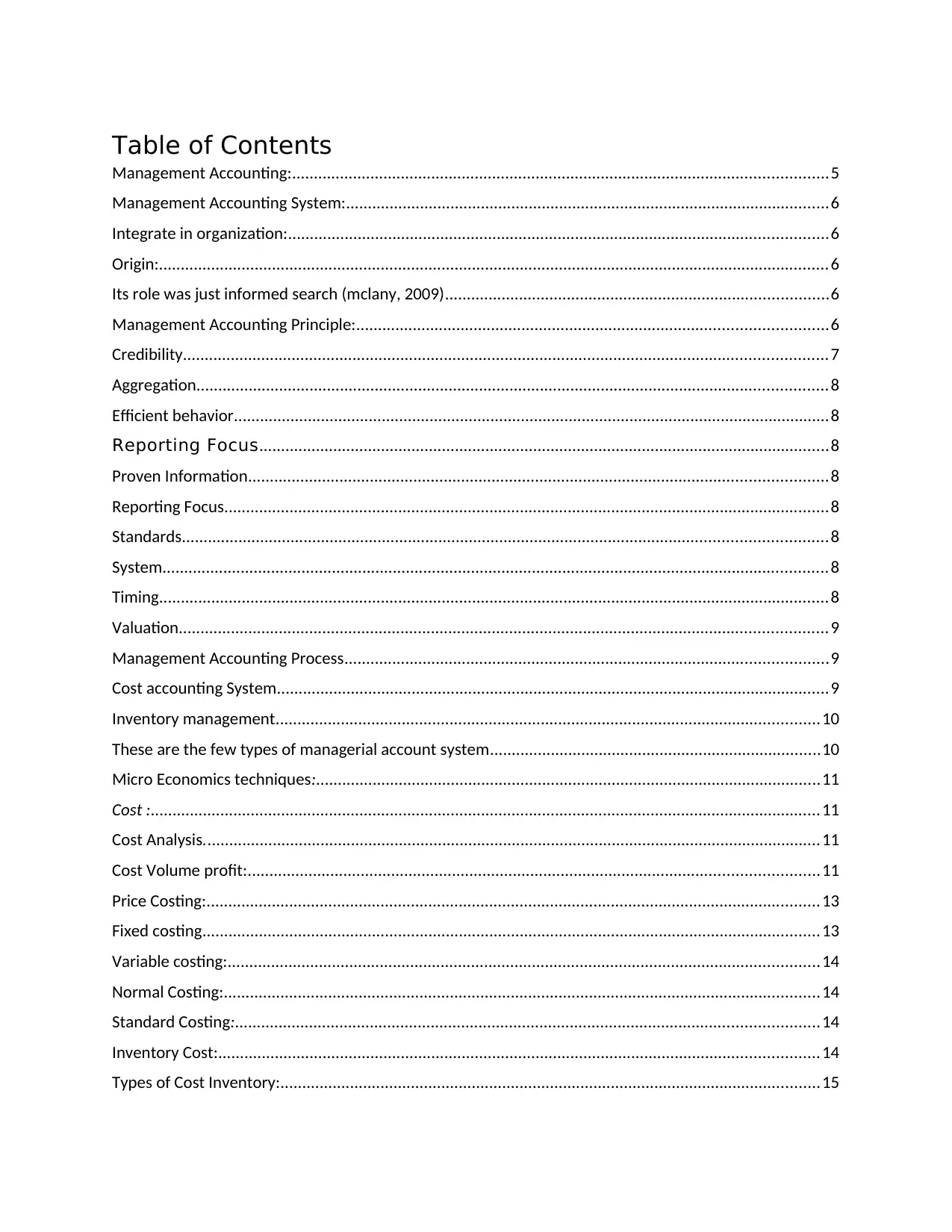
Table of Contents
Management Accounting:...........................................................................................................................5
Management Accounting System:...............................................................................................................6
Integrate in organization:............................................................................................................................6
Origin:..........................................................................................................................................................6
Its role was just informed search (mclany, 2009)........................................................................................6
Management Accounting Principle:............................................................................................................6
Credibility....................................................................................................................................................7
Aggregation.................................................................................................................................................8
Efficient behavior.........................................................................................................................................8
Reporting Focus...................................................................................................................................8
Proven Information.....................................................................................................................................8
Reporting Focus...........................................................................................................................................8
Standards....................................................................................................................................................8
System.........................................................................................................................................................8
Timing..........................................................................................................................................................8
Valuation.....................................................................................................................................................9
Management Accounting Process...............................................................................................................9
Cost accounting System...............................................................................................................................9
Inventory management.............................................................................................................................10
These are the few types of managerial account system............................................................................10
Micro Economics techniques:....................................................................................................................11
Cost :..........................................................................................................................................................11
Cost Analysis..............................................................................................................................................11
Cost Volume profit:...................................................................................................................................11
Price Costing:.............................................................................................................................................13
Fixed costing..............................................................................................................................................13
Variable costing:........................................................................................................................................14
Normal Costing:.........................................................................................................................................14
Standard Costing:......................................................................................................................................14
Inventory Cost:..........................................................................................................................................14
Types of Cost Inventory:............................................................................................................................15
Management Accounting:...........................................................................................................................5
Management Accounting System:...............................................................................................................6
Integrate in organization:............................................................................................................................6
Origin:..........................................................................................................................................................6
Its role was just informed search (mclany, 2009)........................................................................................6
Management Accounting Principle:............................................................................................................6
Credibility....................................................................................................................................................7
Aggregation.................................................................................................................................................8
Efficient behavior.........................................................................................................................................8
Reporting Focus...................................................................................................................................8
Proven Information.....................................................................................................................................8
Reporting Focus...........................................................................................................................................8
Standards....................................................................................................................................................8
System.........................................................................................................................................................8
Timing..........................................................................................................................................................8
Valuation.....................................................................................................................................................9
Management Accounting Process...............................................................................................................9
Cost accounting System...............................................................................................................................9
Inventory management.............................................................................................................................10
These are the few types of managerial account system............................................................................10
Micro Economics techniques:....................................................................................................................11
Cost :..........................................................................................................................................................11
Cost Analysis..............................................................................................................................................11
Cost Volume profit:...................................................................................................................................11
Price Costing:.............................................................................................................................................13
Fixed costing..............................................................................................................................................13
Variable costing:........................................................................................................................................14
Normal Costing:.........................................................................................................................................14
Standard Costing:......................................................................................................................................14
Inventory Cost:..........................................................................................................................................14
Types of Cost Inventory:............................................................................................................................15
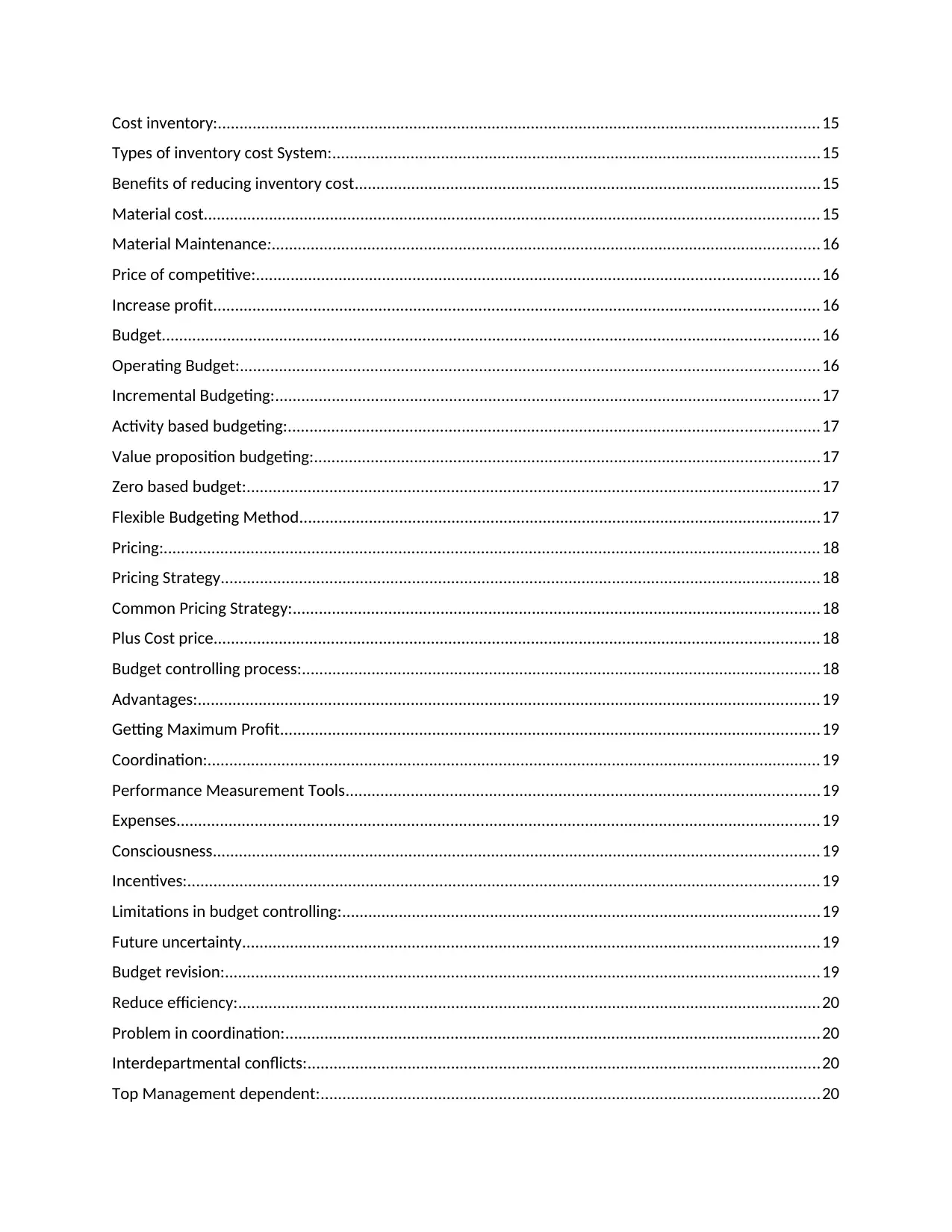
Cost inventory:..........................................................................................................................................15
Types of inventory cost System:................................................................................................................15
Benefits of reducing inventory cost...........................................................................................................15
Material cost.............................................................................................................................................15
Material Maintenance:..............................................................................................................................16
Price of competitive:.................................................................................................................................16
Increase profit...........................................................................................................................................16
Budget.......................................................................................................................................................16
Operating Budget:.....................................................................................................................................16
Incremental Budgeting:.............................................................................................................................17
Activity based budgeting:..........................................................................................................................17
Value proposition budgeting:....................................................................................................................17
Zero based budget:....................................................................................................................................17
Flexible Budgeting Method........................................................................................................................17
Pricing:.......................................................................................................................................................18
Pricing Strategy..........................................................................................................................................18
Common Pricing Strategy:.........................................................................................................................18
Plus Cost price...........................................................................................................................................18
Budget controlling process:.......................................................................................................................18
Advantages:...............................................................................................................................................19
Getting Maximum Profit............................................................................................................................19
Coordination:.............................................................................................................................................19
Performance Measurement Tools.............................................................................................................19
Expenses....................................................................................................................................................19
Consciousness...........................................................................................................................................19
Incentives:.................................................................................................................................................19
Limitations in budget controlling:..............................................................................................................19
Future uncertainty.....................................................................................................................................19
Budget revision:.........................................................................................................................................19
Reduce efficiency:......................................................................................................................................20
Problem in coordination:...........................................................................................................................20
Interdepartmental conflicts:......................................................................................................................20
Top Management dependent:...................................................................................................................20
Types of inventory cost System:................................................................................................................15
Benefits of reducing inventory cost...........................................................................................................15
Material cost.............................................................................................................................................15
Material Maintenance:..............................................................................................................................16
Price of competitive:.................................................................................................................................16
Increase profit...........................................................................................................................................16
Budget.......................................................................................................................................................16
Operating Budget:.....................................................................................................................................16
Incremental Budgeting:.............................................................................................................................17
Activity based budgeting:..........................................................................................................................17
Value proposition budgeting:....................................................................................................................17
Zero based budget:....................................................................................................................................17
Flexible Budgeting Method........................................................................................................................17
Pricing:.......................................................................................................................................................18
Pricing Strategy..........................................................................................................................................18
Common Pricing Strategy:.........................................................................................................................18
Plus Cost price...........................................................................................................................................18
Budget controlling process:.......................................................................................................................18
Advantages:...............................................................................................................................................19
Getting Maximum Profit............................................................................................................................19
Coordination:.............................................................................................................................................19
Performance Measurement Tools.............................................................................................................19
Expenses....................................................................................................................................................19
Consciousness...........................................................................................................................................19
Incentives:.................................................................................................................................................19
Limitations in budget controlling:..............................................................................................................19
Future uncertainty.....................................................................................................................................19
Budget revision:.........................................................................................................................................19
Reduce efficiency:......................................................................................................................................20
Problem in coordination:...........................................................................................................................20
Interdepartmental conflicts:......................................................................................................................20
Top Management dependent:...................................................................................................................20
⊘ This is a preview!⊘
Do you want full access?
Subscribe today to unlock all pages.

Trusted by 1+ million students worldwide
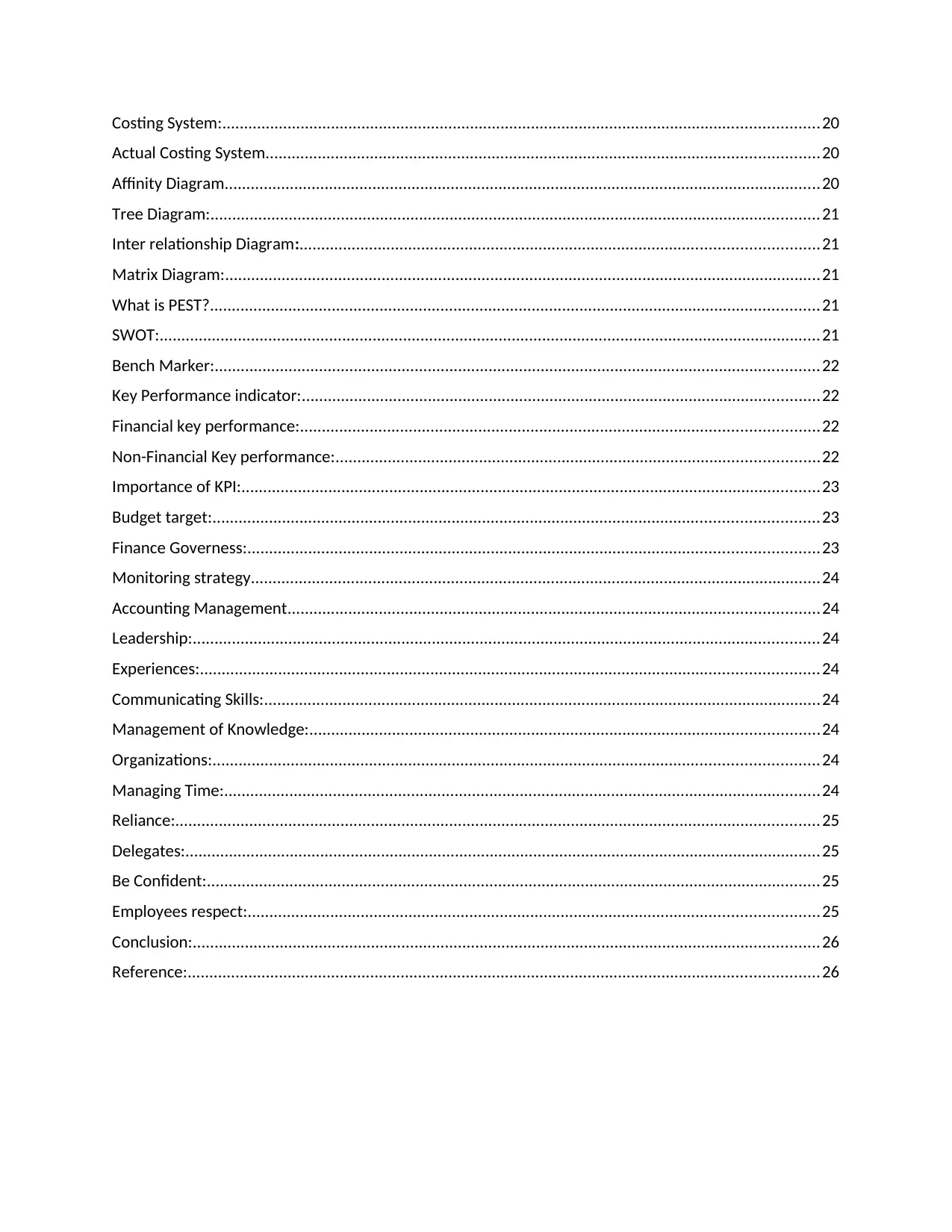
Costing System:.........................................................................................................................................20
Actual Costing System...............................................................................................................................20
Affinity Diagram.........................................................................................................................................20
Tree Diagram:............................................................................................................................................21
Inter relationship Diagram:.......................................................................................................................21
Matrix Diagram:.........................................................................................................................................21
What is PEST?............................................................................................................................................21
SWOT:........................................................................................................................................................21
Bench Marker:...........................................................................................................................................22
Key Performance indicator:.......................................................................................................................22
Financial key performance:.......................................................................................................................22
Non-Financial Key performance:...............................................................................................................22
Importance of KPI:.....................................................................................................................................23
Budget target:...........................................................................................................................................23
Finance Governess:...................................................................................................................................23
Monitoring strategy...................................................................................................................................24
Accounting Management..........................................................................................................................24
Leadership:................................................................................................................................................24
Experiences:..............................................................................................................................................24
Communicating Skills:................................................................................................................................24
Management of Knowledge:.....................................................................................................................24
Organizations:...........................................................................................................................................24
Managing Time:.........................................................................................................................................24
Reliance:....................................................................................................................................................25
Delegates:..................................................................................................................................................25
Be Confident:.............................................................................................................................................25
Employees respect:...................................................................................................................................25
Conclusion:................................................................................................................................................26
Reference:.................................................................................................................................................26
Actual Costing System...............................................................................................................................20
Affinity Diagram.........................................................................................................................................20
Tree Diagram:............................................................................................................................................21
Inter relationship Diagram:.......................................................................................................................21
Matrix Diagram:.........................................................................................................................................21
What is PEST?............................................................................................................................................21
SWOT:........................................................................................................................................................21
Bench Marker:...........................................................................................................................................22
Key Performance indicator:.......................................................................................................................22
Financial key performance:.......................................................................................................................22
Non-Financial Key performance:...............................................................................................................22
Importance of KPI:.....................................................................................................................................23
Budget target:...........................................................................................................................................23
Finance Governess:...................................................................................................................................23
Monitoring strategy...................................................................................................................................24
Accounting Management..........................................................................................................................24
Leadership:................................................................................................................................................24
Experiences:..............................................................................................................................................24
Communicating Skills:................................................................................................................................24
Management of Knowledge:.....................................................................................................................24
Organizations:...........................................................................................................................................24
Managing Time:.........................................................................................................................................24
Reliance:....................................................................................................................................................25
Delegates:..................................................................................................................................................25
Be Confident:.............................................................................................................................................25
Employees respect:...................................................................................................................................25
Conclusion:................................................................................................................................................26
Reference:.................................................................................................................................................26
Paraphrase This Document
Need a fresh take? Get an instant paraphrase of this document with our AI Paraphraser
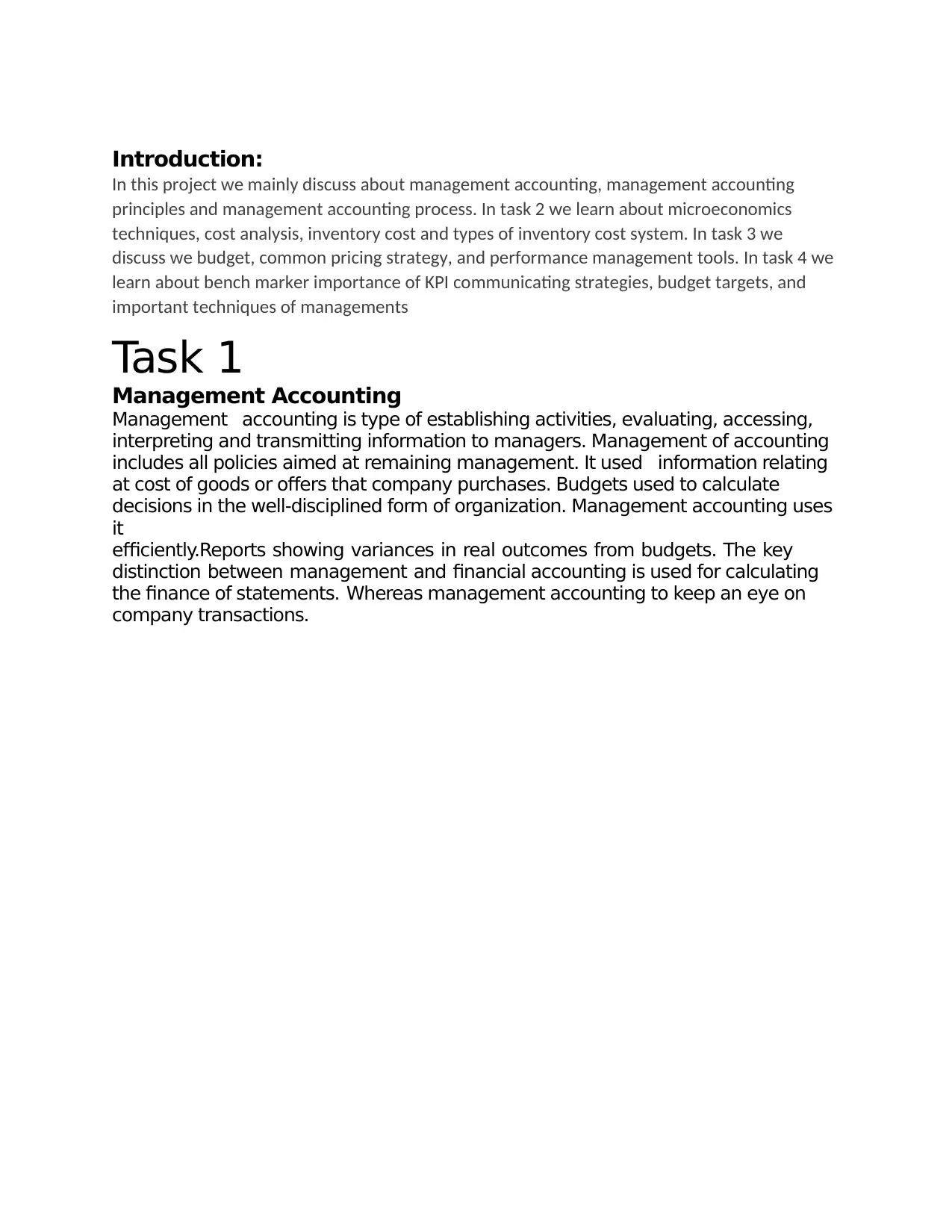
Introduction:
In this project we mainly discuss about management accounting, management accounting
principles and management accounting process. In task 2 we learn about microeconomics
techniques, cost analysis, inventory cost and types of inventory cost system. In task 3 we
discuss we budget, common pricing strategy, and performance management tools. In task 4 we
learn about bench marker importance of KPI communicating strategies, budget targets, and
important techniques of managements
Task 1
Management Accounting
Management accounting is type of establishing activities, evaluating, accessing,
interpreting and transmitting information to managers. Management of accounting
includes all policies aimed at remaining management. It used information relating
at cost of goods or offers that company purchases. Budgets used to calculate
decisions in the well-disciplined form of organization. Management accounting uses
it
efficiently.Reports showing variances in real outcomes from budgets. The key
distinction between management and financial accounting is used for calculating
the finance of statements. Whereas management accounting to keep an eye on
company transactions.
In this project we mainly discuss about management accounting, management accounting
principles and management accounting process. In task 2 we learn about microeconomics
techniques, cost analysis, inventory cost and types of inventory cost system. In task 3 we
discuss we budget, common pricing strategy, and performance management tools. In task 4 we
learn about bench marker importance of KPI communicating strategies, budget targets, and
important techniques of managements
Task 1
Management Accounting
Management accounting is type of establishing activities, evaluating, accessing,
interpreting and transmitting information to managers. Management of accounting
includes all policies aimed at remaining management. It used information relating
at cost of goods or offers that company purchases. Budgets used to calculate
decisions in the well-disciplined form of organization. Management accounting uses
it
efficiently.Reports showing variances in real outcomes from budgets. The key
distinction between management and financial accounting is used for calculating
the finance of statements. Whereas management accounting to keep an eye on
company transactions.

Management Accounting System:
Internal accounting management systems does not used to give
important managing knowledge for the decision-
making of operational business. A company that manufacture use the system
in assist in costing and management of their process. [Peshori, Kishore 2015] The
hospital can use management system to assist Them along with for
insurance other in house billing requirement.
This system different within industries to provide functions
Integrate in organization:
Management accounting
lets administrators within an organization make choices. It is also known as
cost accounting, management accounting that is method of defining
evaluating, interpreting and transmitting facts to administrators in
helping accomplish company objectives. Both accounting areas covering the
administration of corporate activities related to the expense of goods or servi
ces obtained by the organisation shall
be included in the data gathered (Research Report No. R-1428-08-
RR). Accountants use budgets to calculate the corporate spending schedule.
The report on success is used for observing the disparity between current ou
tcomes and the expected results.
Origin:
Its role was just informed search (mclany, 2009)
This website of the institute of management accountant describe management accounting as
“A profession that involves partnering in management decision making, planning and
performance management system”.
Management Accounting Principle:
1. Influence :Communication provides a vital perspective. Communication is beginning and end
of accounting administration. It enhances decision-making by having the necessary insight into all
decision-making processes. Sound exchange of vital knowledge allows management accounting to
intersect silos and facilities an interconnected thinking process process. The effects of steps taken in one
company divide on the other divide can be readily interpreted, accepted or altered.It is also easier to
create and analyses the most important knowledge when addressing the criteria of company decision-
makers. It means that it is necessary for the decision maker to make recommendations and to obtain
influence.
2. Plausibility:For everybody, knowledge is important. Management accounting tests for the best
possible information services, important to the decision made by the people who decide themselves
It needs to achieve a right balance: Present, current and future-related information Foreign and internal
data. Financial and non-financial information, for example environmental and social problems
Internal accounting management systems does not used to give
important managing knowledge for the decision-
making of operational business. A company that manufacture use the system
in assist in costing and management of their process. [Peshori, Kishore 2015] The
hospital can use management system to assist Them along with for
insurance other in house billing requirement.
This system different within industries to provide functions
Integrate in organization:
Management accounting
lets administrators within an organization make choices. It is also known as
cost accounting, management accounting that is method of defining
evaluating, interpreting and transmitting facts to administrators in
helping accomplish company objectives. Both accounting areas covering the
administration of corporate activities related to the expense of goods or servi
ces obtained by the organisation shall
be included in the data gathered (Research Report No. R-1428-08-
RR). Accountants use budgets to calculate the corporate spending schedule.
The report on success is used for observing the disparity between current ou
tcomes and the expected results.
Origin:
Its role was just informed search (mclany, 2009)
This website of the institute of management accountant describe management accounting as
“A profession that involves partnering in management decision making, planning and
performance management system”.
Management Accounting Principle:
1. Influence :Communication provides a vital perspective. Communication is beginning and end
of accounting administration. It enhances decision-making by having the necessary insight into all
decision-making processes. Sound exchange of vital knowledge allows management accounting to
intersect silos and facilities an interconnected thinking process process. The effects of steps taken in one
company divide on the other divide can be readily interpreted, accepted or altered.It is also easier to
create and analyses the most important knowledge when addressing the criteria of company decision-
makers. It means that it is necessary for the decision maker to make recommendations and to obtain
influence.
2. Plausibility:For everybody, knowledge is important. Management accounting tests for the best
possible information services, important to the decision made by the people who decide themselves
It needs to achieve a right balance: Present, current and future-related information Foreign and internal
data. Financial and non-financial information, for example environmental and social problems
⊘ This is a preview!⊘
Do you want full access?
Subscribe today to unlock all pages.

Trusted by 1+ million students worldwide
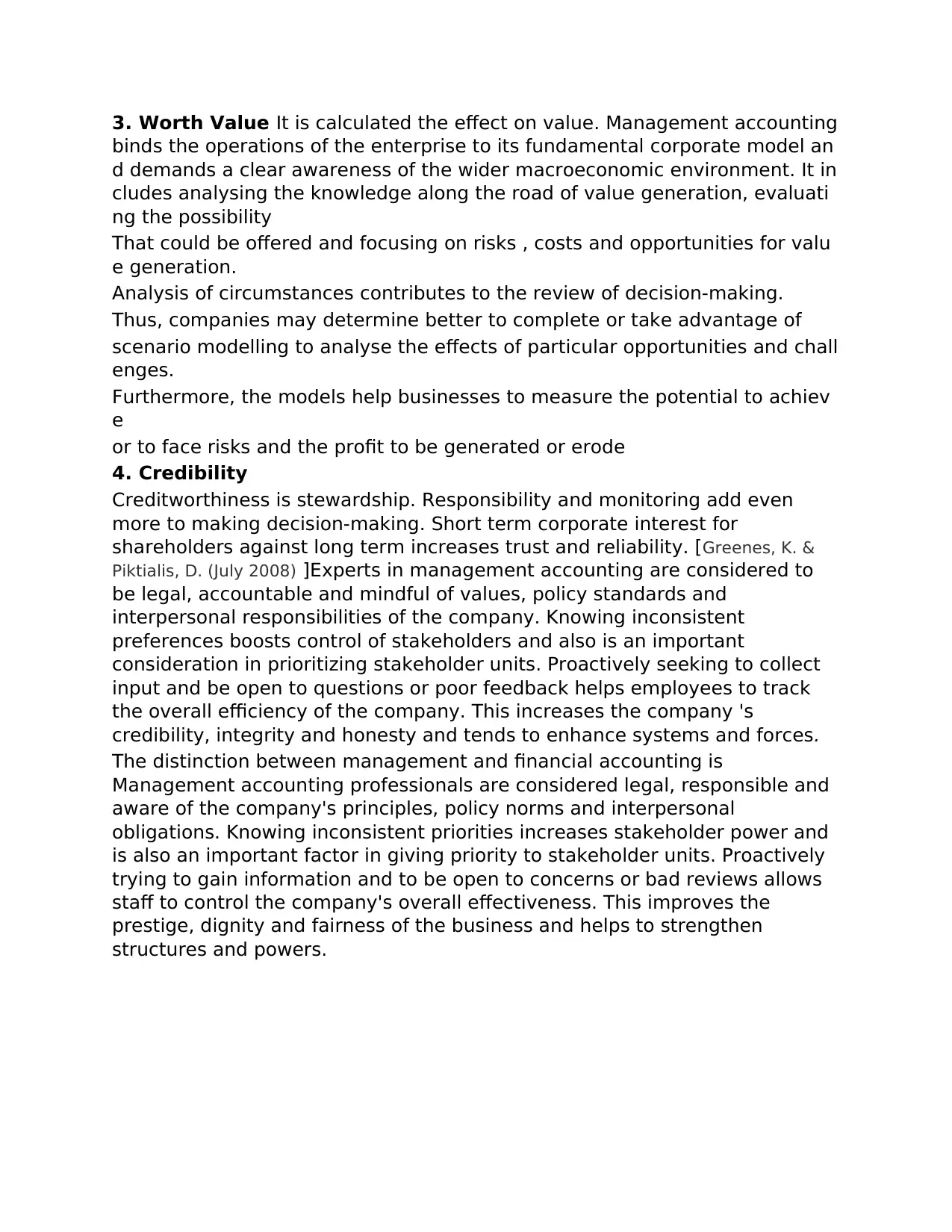
3. Worth Value It is calculated the effect on value. Management accounting
binds the operations of the enterprise to its fundamental corporate model an
d demands a clear awareness of the wider macroeconomic environment. It in
cludes analysing the knowledge along the road of value generation, evaluati
ng the possibility
That could be offered and focusing on risks , costs and opportunities for valu
e generation.
Analysis of circumstances contributes to the review of decision-making.
Thus, companies may determine better to complete or take advantage of
scenario modelling to analyse the effects of particular opportunities and chall
enges.
Furthermore, the models help businesses to measure the potential to achiev
e
or to face risks and the profit to be generated or erode
4. Credibility
Creditworthiness is stewardship. Responsibility and monitoring add even
more to making decision-making. Short term corporate interest for
shareholders against long term increases trust and reliability. [Greenes, K. &
Piktialis, D. (July 2008) ]Experts in management accounting are considered to
be legal, accountable and mindful of values, policy standards and
interpersonal responsibilities of the company. Knowing inconsistent
preferences boosts control of stakeholders and also is an important
consideration in prioritizing stakeholder units. Proactively seeking to collect
input and be open to questions or poor feedback helps employees to track
the overall efficiency of the company. This increases the company 's
credibility, integrity and honesty and tends to enhance systems and forces.
The distinction between management and financial accounting is
Management accounting professionals are considered legal, responsible and
aware of the company's principles, policy norms and interpersonal
obligations. Knowing inconsistent priorities increases stakeholder power and
is also an important factor in giving priority to stakeholder units. Proactively
trying to gain information and to be open to concerns or bad reviews allows
staff to control the company's overall effectiveness. This improves the
prestige, dignity and fairness of the business and helps to strengthen
structures and powers.
binds the operations of the enterprise to its fundamental corporate model an
d demands a clear awareness of the wider macroeconomic environment. It in
cludes analysing the knowledge along the road of value generation, evaluati
ng the possibility
That could be offered and focusing on risks , costs and opportunities for valu
e generation.
Analysis of circumstances contributes to the review of decision-making.
Thus, companies may determine better to complete or take advantage of
scenario modelling to analyse the effects of particular opportunities and chall
enges.
Furthermore, the models help businesses to measure the potential to achiev
e
or to face risks and the profit to be generated or erode
4. Credibility
Creditworthiness is stewardship. Responsibility and monitoring add even
more to making decision-making. Short term corporate interest for
shareholders against long term increases trust and reliability. [Greenes, K. &
Piktialis, D. (July 2008) ]Experts in management accounting are considered to
be legal, accountable and mindful of values, policy standards and
interpersonal responsibilities of the company. Knowing inconsistent
preferences boosts control of stakeholders and also is an important
consideration in prioritizing stakeholder units. Proactively seeking to collect
input and be open to questions or poor feedback helps employees to track
the overall efficiency of the company. This increases the company 's
credibility, integrity and honesty and tends to enhance systems and forces.
The distinction between management and financial accounting is
Management accounting professionals are considered legal, responsible and
aware of the company's principles, policy norms and interpersonal
obligations. Knowing inconsistent priorities increases stakeholder power and
is also an important factor in giving priority to stakeholder units. Proactively
trying to gain information and to be open to concerns or bad reviews allows
staff to control the company's overall effectiveness. This improves the
prestige, dignity and fairness of the business and helps to strengthen
structures and powers.
Paraphrase This Document
Need a fresh take? Get an instant paraphrase of this document with our AI Paraphraser

The disparity between financial accounting and management is as much as
5.Aggregation
Earnings for a whole company are reported in financial accounting. In handlin
g budgets, the income by the product, product line, client and geographical a
rea are almost always more comprehensive.
Efficient behavior
Financial accounting report on performance of a company, while
Reporting Focus
The requirement of functional accounting is on the documents to be held
with significant accuracy to show their correctness. Management accounting
also presents estimates instead of verifiable and confirmed evidence
(Accounting Made Simple –by Mike Piper)
Proven Information
Financial accounting requires the accuracy of documents, which are used to
prove the accuracy of financial statements. Management accounts also work
with estimates instead of verifiable variables that have been confirmed.
Reporting Focus
Financial management is directed at the production of financial records, both
in- and out of-society. Operational accounts, which only distribute within a co
mpany, concern management accounting
Standards
Financial accounting must follow different accounting requirements, while ad
ministrative accounting
must not meet such standards when data is gathered for domestic use.
System
The total method a organisation will earn profit should not pay much attentio
n to financial accounting but for its result. Inversely, administrators tend to s
ee where bottleneck processes take place and how to boost their profits by a
ddressing challenges with a bottleneck.
Timing
Financial accounting demands that at the conclusion of an accounting cycle
the financial reports be published. Managers should report more often and it
offers information that is more valuable to managers because they see it
immediately
Valuation
5.Aggregation
Earnings for a whole company are reported in financial accounting. In handlin
g budgets, the income by the product, product line, client and geographical a
rea are almost always more comprehensive.
Efficient behavior
Financial accounting report on performance of a company, while
Reporting Focus
The requirement of functional accounting is on the documents to be held
with significant accuracy to show their correctness. Management accounting
also presents estimates instead of verifiable and confirmed evidence
(Accounting Made Simple –by Mike Piper)
Proven Information
Financial accounting requires the accuracy of documents, which are used to
prove the accuracy of financial statements. Management accounts also work
with estimates instead of verifiable variables that have been confirmed.
Reporting Focus
Financial management is directed at the production of financial records, both
in- and out of-society. Operational accounts, which only distribute within a co
mpany, concern management accounting
Standards
Financial accounting must follow different accounting requirements, while ad
ministrative accounting
must not meet such standards when data is gathered for domestic use.
System
The total method a organisation will earn profit should not pay much attentio
n to financial accounting but for its result. Inversely, administrators tend to s
ee where bottleneck processes take place and how to boost their profits by a
ddressing challenges with a bottleneck.
Timing
Financial accounting demands that at the conclusion of an accounting cycle
the financial reports be published. Managers should report more often and it
offers information that is more valuable to managers because they see it
immediately
Valuation

Financial management addresses the correct appraisal of properties and
obligations and thereby deficiencies, reassessments, etc. The valuation of
these things, just their productivity, is not associated with management
accounting.
Management Accounting Process
There are two main types of management accounting system namely
Costing system
Inventory Management
Cost accounting System
In order to measure the cost of its goods in terms of inventory assessment, profitability
measurement and cost management, the company applied a costing method or costing system.
Cost distribution is based on both the activity-based costing system and the conventional costing
system in the cost accounting system. For efficient functions, approximating the real prices of
goods is important Cost accounts are the type of accounting system intended to collect
operating costs by weighing the supply costs or production managemental financial problem
assessment The costing system Managers rely on accounting data generally and specifically on c
ost, as their cost can explain any task of the
company. Cost accounting is considered as a core principle of management accounting since it p
rovides the empirical means for ensuring that management successfully performs its reproductiv
ity, such as budgetary regulation, marginal cost, Normal costing, running costs and inventory co
ntrol. (Accounting Made Simple –by Mike Piper)
obligations and thereby deficiencies, reassessments, etc. The valuation of
these things, just their productivity, is not associated with management
accounting.
Management Accounting Process
There are two main types of management accounting system namely
Costing system
Inventory Management
Cost accounting System
In order to measure the cost of its goods in terms of inventory assessment, profitability
measurement and cost management, the company applied a costing method or costing system.
Cost distribution is based on both the activity-based costing system and the conventional costing
system in the cost accounting system. For efficient functions, approximating the real prices of
goods is important Cost accounts are the type of accounting system intended to collect
operating costs by weighing the supply costs or production managemental financial problem
assessment The costing system Managers rely on accounting data generally and specifically on c
ost, as their cost can explain any task of the
company. Cost accounting is considered as a core principle of management accounting since it p
rovides the empirical means for ensuring that management successfully performs its reproductiv
ity, such as budgetary regulation, marginal cost, Normal costing, running costs and inventory co
ntrol. (Accounting Made Simple –by Mike Piper)
⊘ This is a preview!⊘
Do you want full access?
Subscribe today to unlock all pages.

Trusted by 1+ million students worldwide
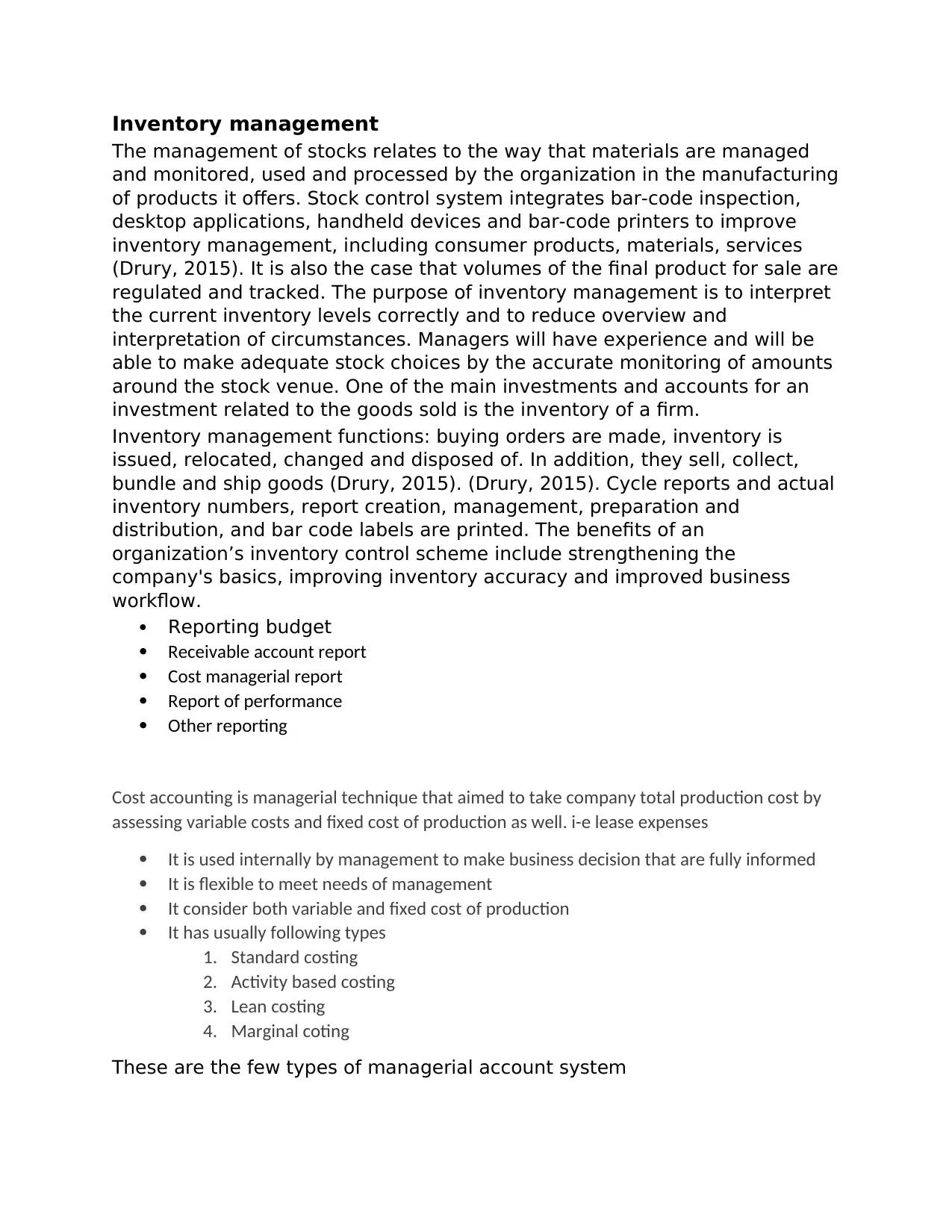
Inventory management
The management of stocks relates to the way that materials are managed
and monitored, used and processed by the organization in the manufacturing
of products it offers. Stock control system integrates bar-code inspection,
desktop applications, handheld devices and bar-code printers to improve
inventory management, including consumer products, materials, services
(Drury, 2015). It is also the case that volumes of the final product for sale are
regulated and tracked. The purpose of inventory management is to interpret
the current inventory levels correctly and to reduce overview and
interpretation of circumstances. Managers will have experience and will be
able to make adequate stock choices by the accurate monitoring of amounts
around the stock venue. One of the main investments and accounts for an
investment related to the goods sold is the inventory of a firm.
Inventory management functions: buying orders are made, inventory is
issued, relocated, changed and disposed of. In addition, they sell, collect,
bundle and ship goods (Drury, 2015). (Drury, 2015). Cycle reports and actual
inventory numbers, report creation, management, preparation and
distribution, and bar code labels are printed. The benefits of an
organization’s inventory control scheme include strengthening the
company's basics, improving inventory accuracy and improved business
workflow.
Reporting budget
Receivable account report
Cost managerial report
Report of performance
Other reporting
Cost accounting is managerial technique that aimed to take company total production cost by
assessing variable costs and fixed cost of production as well. i-e lease expenses
It is used internally by management to make business decision that are fully informed
It is flexible to meet needs of management
It consider both variable and fixed cost of production
It has usually following types
1. Standard costing
2. Activity based costing
3. Lean costing
4. Marginal coting
These are the few types of managerial account system
The management of stocks relates to the way that materials are managed
and monitored, used and processed by the organization in the manufacturing
of products it offers. Stock control system integrates bar-code inspection,
desktop applications, handheld devices and bar-code printers to improve
inventory management, including consumer products, materials, services
(Drury, 2015). It is also the case that volumes of the final product for sale are
regulated and tracked. The purpose of inventory management is to interpret
the current inventory levels correctly and to reduce overview and
interpretation of circumstances. Managers will have experience and will be
able to make adequate stock choices by the accurate monitoring of amounts
around the stock venue. One of the main investments and accounts for an
investment related to the goods sold is the inventory of a firm.
Inventory management functions: buying orders are made, inventory is
issued, relocated, changed and disposed of. In addition, they sell, collect,
bundle and ship goods (Drury, 2015). (Drury, 2015). Cycle reports and actual
inventory numbers, report creation, management, preparation and
distribution, and bar code labels are printed. The benefits of an
organization’s inventory control scheme include strengthening the
company's basics, improving inventory accuracy and improved business
workflow.
Reporting budget
Receivable account report
Cost managerial report
Report of performance
Other reporting
Cost accounting is managerial technique that aimed to take company total production cost by
assessing variable costs and fixed cost of production as well. i-e lease expenses
It is used internally by management to make business decision that are fully informed
It is flexible to meet needs of management
It consider both variable and fixed cost of production
It has usually following types
1. Standard costing
2. Activity based costing
3. Lean costing
4. Marginal coting
These are the few types of managerial account system
Paraphrase This Document
Need a fresh take? Get an instant paraphrase of this document with our AI Paraphraser
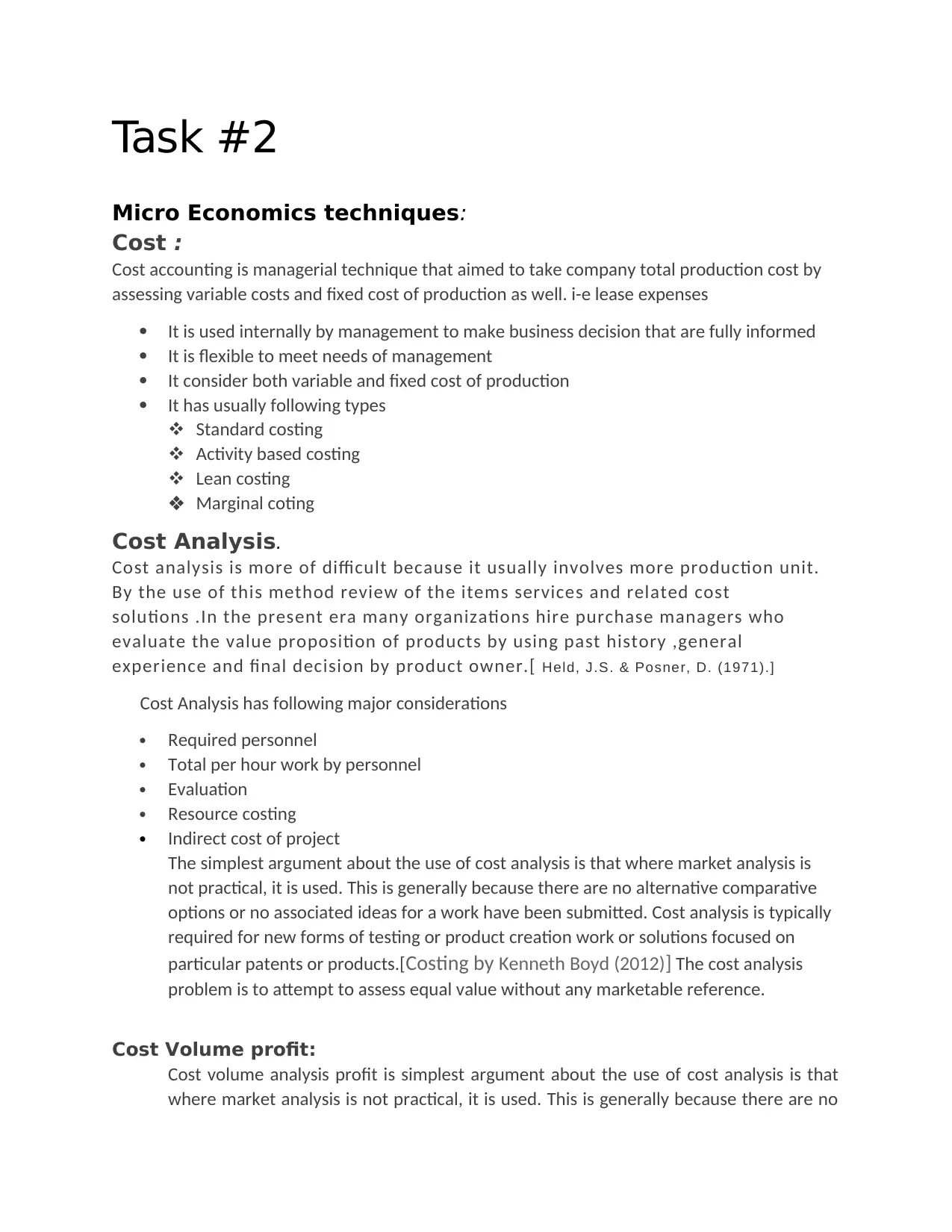
Task #2
Micro Economics techniques:
Cost :
Cost accounting is managerial technique that aimed to take company total production cost by
assessing variable costs and fixed cost of production as well. i-e lease expenses
It is used internally by management to make business decision that are fully informed
It is flexible to meet needs of management
It consider both variable and fixed cost of production
It has usually following types
Standard costing
Activity based costing
Lean costing
Marginal coting
Cost Analysis.
Cost analysis is more of difficult because it usually involves more production unit.
By the use of this method review of the items services and related cost
solutions .In the present era many organizations hire purchase managers who
evaluate the value proposition of products by using past history ,general
experience and final decision by product owner.[ Held, J.S. & Posner, D. (1971).]
Cost Analysis has following major considerations
Required personnel
Total per hour work by personnel
Evaluation
Resource costing
Indirect cost of project
The simplest argument about the use of cost analysis is that where market analysis is
not practical, it is used. This is generally because there are no alternative comparative
options or no associated ideas for a work have been submitted. Cost analysis is typically
required for new forms of testing or product creation work or solutions focused on
particular patents or products.[Costing by Kenneth Boyd (2012)] The cost analysis
problem is to attempt to assess equal value without any marketable reference.
Cost Volume profit:
Cost volume analysis profit is simplest argument about the use of cost analysis is that
where market analysis is not practical, it is used. This is generally because there are no
Micro Economics techniques:
Cost :
Cost accounting is managerial technique that aimed to take company total production cost by
assessing variable costs and fixed cost of production as well. i-e lease expenses
It is used internally by management to make business decision that are fully informed
It is flexible to meet needs of management
It consider both variable and fixed cost of production
It has usually following types
Standard costing
Activity based costing
Lean costing
Marginal coting
Cost Analysis.
Cost analysis is more of difficult because it usually involves more production unit.
By the use of this method review of the items services and related cost
solutions .In the present era many organizations hire purchase managers who
evaluate the value proposition of products by using past history ,general
experience and final decision by product owner.[ Held, J.S. & Posner, D. (1971).]
Cost Analysis has following major considerations
Required personnel
Total per hour work by personnel
Evaluation
Resource costing
Indirect cost of project
The simplest argument about the use of cost analysis is that where market analysis is
not practical, it is used. This is generally because there are no alternative comparative
options or no associated ideas for a work have been submitted. Cost analysis is typically
required for new forms of testing or product creation work or solutions focused on
particular patents or products.[Costing by Kenneth Boyd (2012)] The cost analysis
problem is to attempt to assess equal value without any marketable reference.
Cost Volume profit:
Cost volume analysis profit is simplest argument about the use of cost analysis is that
where market analysis is not practical, it is used. This is generally because there are no
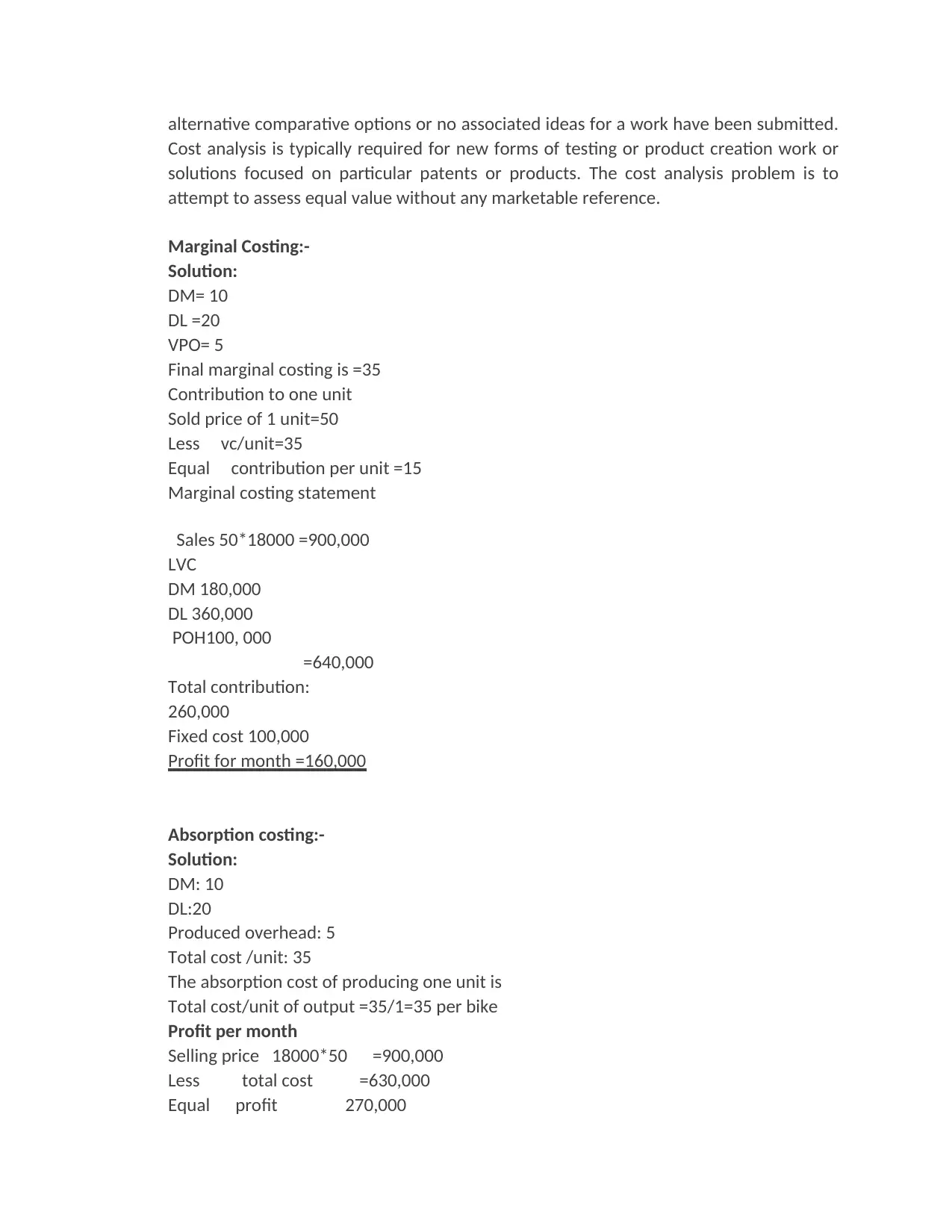
alternative comparative options or no associated ideas for a work have been submitted.
Cost analysis is typically required for new forms of testing or product creation work or
solutions focused on particular patents or products. The cost analysis problem is to
attempt to assess equal value without any marketable reference.
Marginal Costing:-
Solution:
DM= 10
DL =20
VPO= 5
Final marginal costing is =35
Contribution to one unit
Sold price of 1 unit=50
Less vc/unit=35
Equal contribution per unit =15
Marginal costing statement
Sales 50*18000 =900,000
LVC
DM 180,000
DL 360,000
POH100, 000
=640,000
Total contribution:
260,000
Fixed cost 100,000
Profit for month =160,000
Absorption costing:-
Solution:
DM: 10
DL:20
Produced overhead: 5
Total cost /unit: 35
The absorption cost of producing one unit is
Total cost/unit of output =35/1=35 per bike
Profit per month
Selling price 18000*50 =900,000
Less total cost =630,000
Equal profit 270,000
Cost analysis is typically required for new forms of testing or product creation work or
solutions focused on particular patents or products. The cost analysis problem is to
attempt to assess equal value without any marketable reference.
Marginal Costing:-
Solution:
DM= 10
DL =20
VPO= 5
Final marginal costing is =35
Contribution to one unit
Sold price of 1 unit=50
Less vc/unit=35
Equal contribution per unit =15
Marginal costing statement
Sales 50*18000 =900,000
LVC
DM 180,000
DL 360,000
POH100, 000
=640,000
Total contribution:
260,000
Fixed cost 100,000
Profit for month =160,000
Absorption costing:-
Solution:
DM: 10
DL:20
Produced overhead: 5
Total cost /unit: 35
The absorption cost of producing one unit is
Total cost/unit of output =35/1=35 per bike
Profit per month
Selling price 18000*50 =900,000
Less total cost =630,000
Equal profit 270,000
⊘ This is a preview!⊘
Do you want full access?
Subscribe today to unlock all pages.

Trusted by 1+ million students worldwide
1 out of 28
Related Documents
Your All-in-One AI-Powered Toolkit for Academic Success.
+13062052269
info@desklib.com
Available 24*7 on WhatsApp / Email
![[object Object]](/_next/static/media/star-bottom.7253800d.svg)
Unlock your academic potential
Copyright © 2020–2025 A2Z Services. All Rights Reserved. Developed and managed by ZUCOL.



